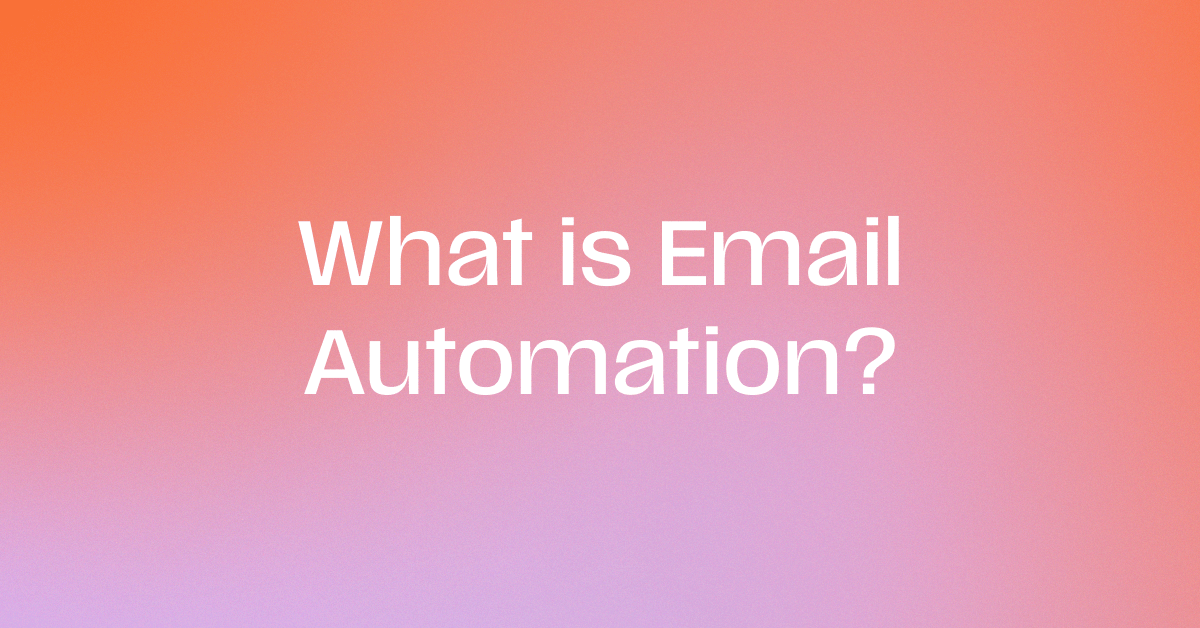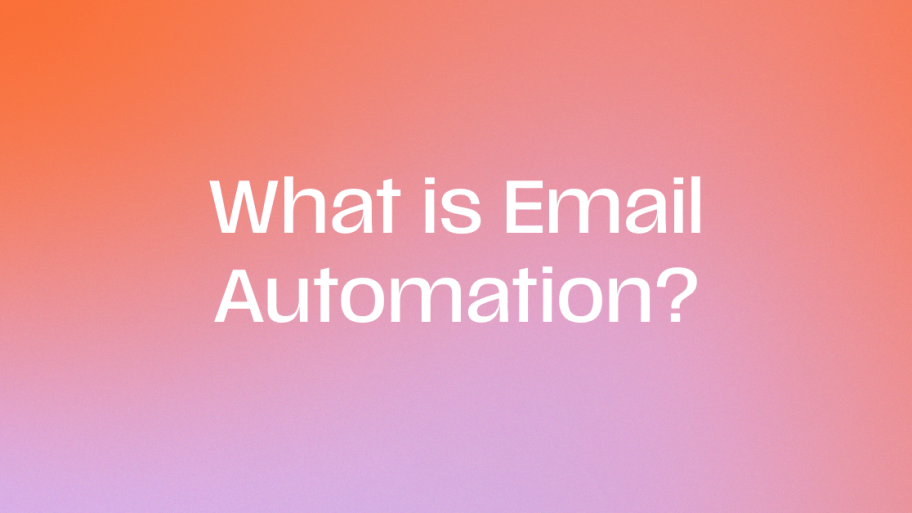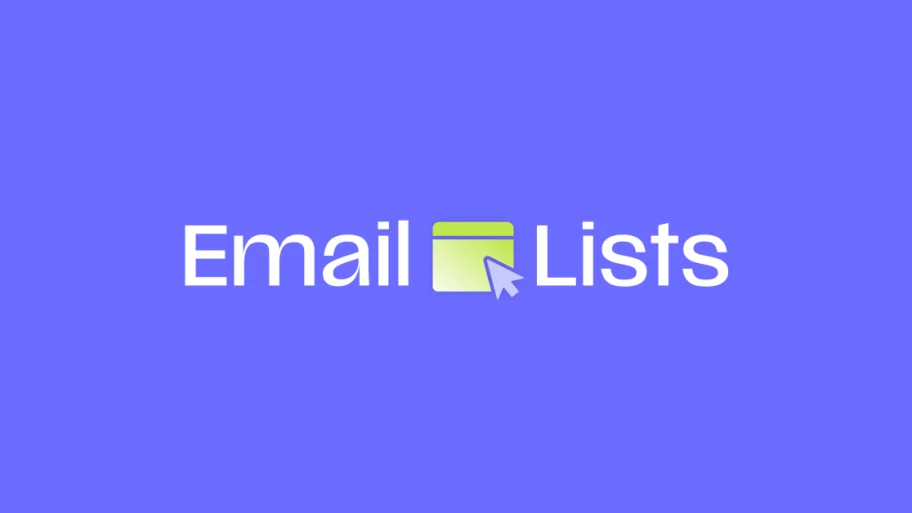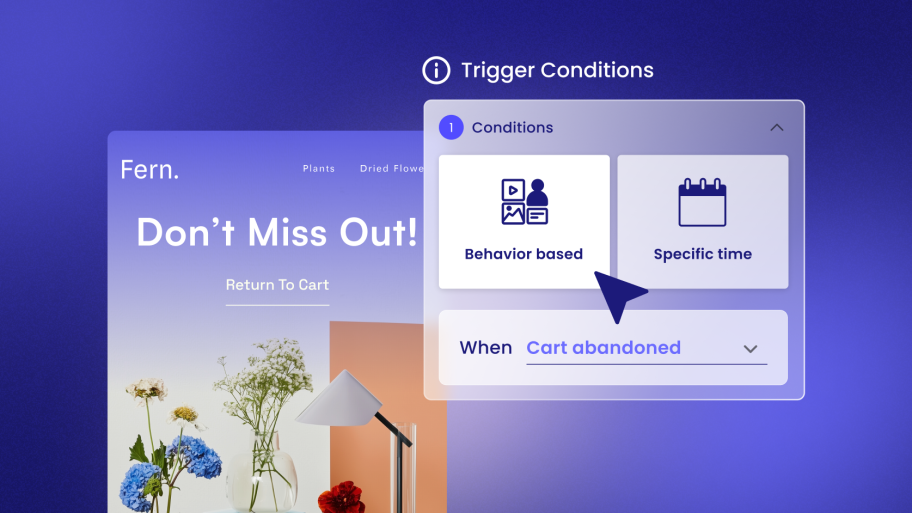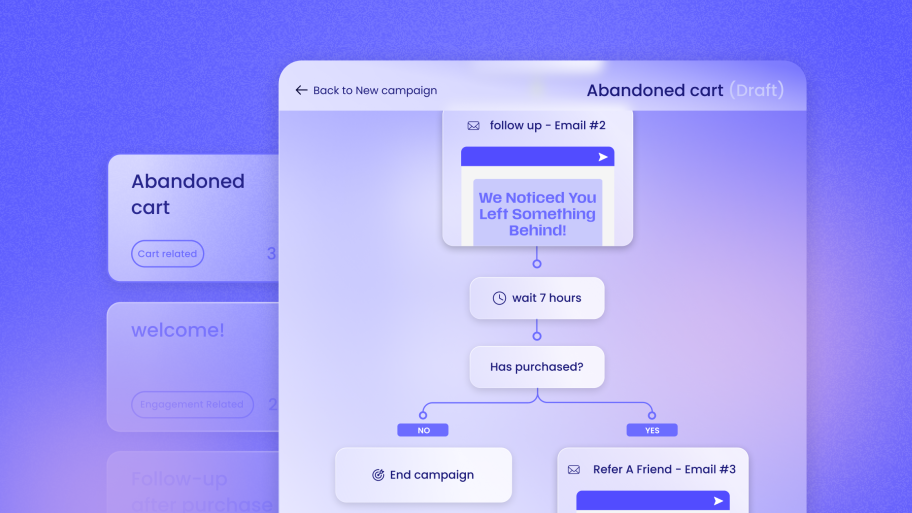Email automation steps in as your round-the-clock assistant, sending perfectly timed messages to exactly who needs them.
This guide breaks down everything you need to know about email automation, from getting started to mastering advanced techniques. You’ll learn how to turn automatic emails into meaningful conversations that drive sales and keep customers coming back.
How Email Automation Really Works
Picture email automation as a smart assistant who knows exactly when to contact your customers. It handles all the repetitive email tasks while you focus on growing your business. The system works through three essential components that work together seamlessly: triggers, actions, and workflows.
Understanding the Core Components
Triggers are specific events or behaviors that set the stage for any automated email sequence. For example, when someone joins your mailing list, abandons their shopping cart, or makes their first purchase, these events can spark an automated response.
Actions follow triggers as the next step in the process. Think of them as the automated responses to those trigger events. When triggered, the system might send out a welcome message, dispatch a reminder about forgotten items, or deliver a thank-you note with a special offer.
Workflows tie everything together into a coherent plan. They create the roadmap for how triggers and actions work together, ensuring each customer receives the right message at the right time.
A well-designed workflow guides customers smoothly through their journey with your brand.
A Simple Example in Action
Consider what happens when someone signs up for your newsletter. The moment they submit their email address, your automation system springs into action.
First, it sends them a warm welcome message with a 15% discount code. If they use that discount to make a purchase, the system automatically moves them to your “active customer” list and begins a new sequence of nurturing emails.
The Technical Side Made Simple
Triggers come in various forms beyond just new subscriptions. Your system can respond to cart abandonments, completed purchases, specific website browsing patterns, and even special dates like birthdays or anniversaries. Each trigger presents an opportunity to connect meaningfully with your audience.
Actions extend beyond simply sending emails. Your automation system can shift subscribers between different lists based on their behavior, update their customer profiles, and adjust their journey based on how they interact with your brand.
This dynamic responsiveness ensures each customer receives increasingly relevant communications over time.
A well-structured workflow brings these elements together in a way that feels natural and personal to the recipient. Despite being automated, these email sequences can create genuine connections with your customers by delivering value at each step of their journey.
The Send Platform makes creating these sophisticated systems surprisingly straightforward. Its intuitive design allows you to map out your email sequences visually, making it accessible whether you’re just starting or looking to refine an existing strategy.
Building Your Email List and Creating Smart Workflows
Size isn’t everything when it comes to email lists. What really counts is having subscribers who can’t wait to open your emails. Before jumping into fancy automation tricks, you need to build a solid foundation of engaged readers.
Smart Ways to Grow Your List
Want to turn website visitors into subscribers? Give them something they can’t resist. Lead magnets [valuable free resources offered in exchange for an email address] are your secret weapon. Think practical guides, insider tips, or exclusive discount codes—something your ideal customer would love to receive.
Keep your signup forms short and sweet to make signing up a breeze. People prefer to fill out endless fields just to get a newsletter. Place your signup forms where they make sense—maybe after a helpful blog post or near related products. A/B testing different locations and messages helps you find what works best.
Want to shake things up? Try running a contest that gets people excited to join your list. Just make sure the prize matches what your ideal customer wants – there’s no point in attracting people who’ll never buy from you. Spreading the word about your mailing list on social media can bring in subscribers who already follow and trust your brand.
Making Your Emails Hit Home
Segmentation [grouping subscribers based on shared traits] turns a one-size-fits-all email list into targeted groups of people who’ll actually care about what you’re sending. Here’s how to slice and dice your list effectively:
Look at who your subscribers are (age, location, interests) and what they do (buying habits, clicking patterns, website visits). This info helps you send emails they’ll actually want to read. Someone who bought winter gear probably doesn’t need summer sale alerts in December.
Watch how people interact with your emails. Your biggest fans deserve special treatment—maybe early access to new products or VIP-only deals. Those who haven’t opened your emails in months might need a different approach or a gentle nudge to re-engage.
The Send Platform makes splitting your list into these focused groups simple. Set up rules once, and it’ll automatically sort new subscribers into the right segments. This means less work for you and more relevant emails for them.
Must-Have Email Workflows
First impressions stick. Your welcome emails set the tone for your entire relationship with new subscribers. Think of them as rolling out the red carpet for potential customers.
Here’s how to structure a winning welcome series:
The instant “hello. “Send this right away. Thank them for joining, remind them why they made a great choice, and throw in that welcome discount you promised. Keep it friendly and genuine.
The story email: Share what makes your brand tick. Skip the corporate speech – tell them why you started your business and what gets you excited about it. Show off a few customer favorites while you’re at it.
The helpful guide: Give them something useful related to your products. Sell coffee? Send brewing tips. Sell workout gear? Share a quick home exercise routine. Show them you’re not just here to sell—you’re here to help.
The perfect match: Based on what has caught their eye so far, suggest products they might love. If they click on running shoes in your welcome email, show them related gear or training advice.
Each email in this sequence teaches you more about what your subscribers like. Pay attention to what they click on—it’ll help you send even better emails later.
Winning Back Lost Sales and Keeping Customers Happy
Rescuing Abandoned Shopping Carts
We’ve all been there – a customer fills their cart but disappears before buying. Cart abandonment emails work like a friendly tap on the shoulder, reminding shoppers about the great stuff they left behind. Here’s the secret sauce to bringing them back:
Strike while the iron’s hot. Send your first reminder within an hour – that’s when their interest is still warm. Make it impossible to resist with phrases like “Your picks are selling fast!” or “These won’t last long!” A small nudge like free shipping or a 10% discount might be all it takes to seal the deal.
Highlight the best features of their chosen items to show them what they’re missing. Better yet, sprinkle in some real customer reviews. Nothing builds trust like seeing others rave about a product. The Send Platform handles all this automatically, sending perfectly timed reminders to bring those shoppers back.
After the Sale: Building Lasting Relationships
Post-purchase communication isn’t just good manners – it’s smart business. When someone buys from you, they’re not just a customer; they’re a potential fan. Here’s how to turn that first purchase into a long-term relationship:
Start with a rock-solid order confirmation. Give them all the details about their purchase and when it’ll arrive. Keep them in the loop with shipping updates – nobody likes wondering where their package is. Once they’ve had time to try their purchase, ask for their honest thoughts. Reviews aren’t just feedback; they’re gold for your business.
Smart sellers know to suggest items that complement what customers just bought. For example, if they bought a coffee maker, they might need filters or a matching milk frother. This thoughtful approach shows you understand their needs while opening doors for future sales.
Promotions That Actually Work
Nobody likes feeling spammed with endless sales pitches. Automated promotional campaigns work best when they feel personal and timely. Here’s how to do it right:
Have you got something new in stock? Give your email subscribers first dibs. Run seasonal sales that make sense – like cozy sweaters when fall hits or beach gear before summer starts. Flash sales create excitement and urgency, especially when timed right. And don’t forget to treat your loyal customers like VIPs with exclusive early access or special discounts.
The key? Match your promotions to what each customer segment actually wants. Sending winter coat deals to folks in Florida won’t win you any friends.
Writing Emails People Actually Want to Read
Nailing Those Subject Lines
Your subject line needs to pack a punch – it’s your one shot to grab attention in a crowded inbox. Make every word count:
Keep it snappy (under 50 characters). Use words that light a fire under readers: “Ending soon,” “Just for you,” or “Limited spots.” Adding their name or mentioning something they looked at shows you’re paying attention. Numbers stand out in a sea of words, and questions make people curious enough to click.
Mix things up and test different approaches. What works for one group might flop with another.
Making Your Emails Look Sharp
A good-looking email pulls readers in and guides them through your message. Some tried-and-true design tips:
Create clear sections with headers that make scanning easy. Mobile optimization [making sure emails look great on phones] isn’t optional anymore – most people check email on their phones. Break up text with images and breathing room, but don’t go overboard. Stick to your brand’s colors and style to keep things consistent.
The Send Platform comes loaded with templates that make your emails look professional without needing design skills.
Getting Personal
True personalization goes way beyond using someone’s name. It’s about making each email feel like it was meant just for them:
Use dynamic content [content that changes based on who’s reading] to show different things to different people. Track what they click and buy to send more of what they like. Send emails triggered by specific actions – like browsing a product page or leaving items in their cart.
When you nail personalization, your emails stop being “marketing” and start being helpful. That’s when you see real results.
Taking Your Email Game to the Next Level
Advanced Techniques That Actually Work
Have you mastered the basics? Let’s step up your email marketing game with some proven strategies that’ll make your campaigns even more effective.
The Power of A/B Testing
A/B testing [comparing two versions of an email to see which performs better] takes the guesswork out of email marketing. Think of it as running a mini-experiment with your emails. Instead of wondering what works best, you’ll know for sure.
Want to test the waters? Try changing up:
- Those all-important subject lines
- The meat of your message
- When you hit ‘send’
- How your emails look
Each test teaches you something new about what makes your subscribers tick. They may prefer funny subject lines over serious ones, or they may be more likely to open emails on Tuesday mornings than on Friday afternoons. Every bit of data helps you craft better emails down the line.
Smart Triggers: Right Message, Right Time
Behavioral-triggered emails respond to what your subscribers actually do, not just when you want to send something. It’s like having a sixth sense for when someone’s ready to hear from you.
Picture this: A customer browses your website’s camping gear section. An hour later, they get an email featuring your top-rated tents and sleeping bags. That’s no coincidence – it’s smart automation at work. Or maybe someone hasn’t opened your emails in a month. A quick “We miss you!” note with a special offer might bring them back.
The Send Platform makes setting up these smart triggers a breeze. You can create workflows that feel like magic to your customers but are actually just well-planned automation sequences.
Crunching the Numbers: What Really Matters
Let’s talk about what you should actually measure. Here are the numbers that tell the real story:
- Open rate: How many people actually open your emails? This tells you if your subject lines are performing well.
- Click-through rate (CTR) [percentage of people who click links in your email]: Shows if your content hits the mark and motivates action.
- Conversion rate [percentage of people who complete your desired action]: The bottom line – are people doing what you want them to do?
- Bounce rate [emails that didn’t make it to inboxes]: High numbers here mean it’s time to clean up your email list.
- Unsubscribe rate: If too many people are jumping ship, something needs fixing.
Making Those Numbers Work for You
Raw data is just the start. Here’s how to turn those insights into better results:
Split your audience into smaller groups based on shared traits or behaviors. The more targeted your emails are, the better they’ll perform. Use what you know about each subscriber to make your messages feel personal. If someone always opens emails about hiking gear, don’t bombard them with skateboard deals.
Test everything. Different subject lines send times and layouts – you name it. Keep what works, and fix what doesn’t. Write like you’re talking to a friend, not giving a lecture. Always make what you want readers to do next crystal clear.
Watch your deliverability [ability to reach inboxes instead of spam folders] like a hawk. The best email in the world is only useful if it reaches its target.
The beauty of email automation is that you can always make tweaks and improvements. Monitor your metrics, adjust your approach, and watch your results improve over time.
Why Send is Your Best Bet for Email Automation
The Perfect Match for WooCommerce Stores
Choosing the right email platform can feel overwhelming—there are so many options.
But if you’re running a WooCommerce store, Send stands out from the pack. It’s built specifically to work with WordPress and WooCommerce, making it the natural choice for shop owners who want powerful email automation without the hassle.
What Makes Send Special?
Send packs quite a punch when it comes to features. Here’s what you’ll get:
A visual workflow builder that makes creating automated email sequences as simple as drawing a flowchart. No coding is needed – just drag and drop, and you’re good to go.
Ready-to-use templates and workflows for common scenarios save you time. Do you want to set up welcome emails or cart abandonment reminders? The hard work’s already done for you.
Smart segmentation [splitting your audience into specific groups] helps you send the right messages to the right people. Sort customers by what they’ve bought, how they behave on your site, or any other criteria that matter to your business.
Dynamic content [content that changes based on who’s viewing it] means each subscriber sees messages tailored just for them. It’s like having a personal shopper for every customer.
Built-in analytics show you exactly how your emails perform. The track opens, clicks, sales, and more – all in one place.
Perfect Integration with Your Store
Here’s where Send really shines for WooCommerce users. It connects directly to your store, putting your customer data to work automatically—no more copying and pasting between systems or wondering if your contact lists are up to date.
The integration opens up some pretty cool possibilities:
- Trigger emails based on what happens in your store (new orders, abandoned carts, etc.)
- Show products your customers will actually want based on what they’ve bought before
- Run targeted promotions to specific customer groups
Everything stays in sync without you lifting a finger. Your store and your emails work together like a well-oiled machine.
Wrapping It Up
We’ve covered a lot of ground in this guide. Let’s hit the highlights one more time:
Email automation saves you precious time. Set it up once, and it will work 24/7. The key is getting personal—sending the right messages to the right people makes all the difference.
Those essential workflows we talked about? They’re not just nice to have—they’re proven money-makers. Welcome emails, cart recovery, and post-purchase follow-ups all add up to better sales and happier customers.
Testing different approaches and watching how people respond helps you achieve better results over time. With Send’s tools for WooCommerce stores, you’ve got everything you need to make it happen.
Ready to Get Started?
Give Send a try—it’s free to test out all these features we’ve talked about. See for yourself how easy it is to create automated email campaigns that generate sales and keep customers coming back for more.
